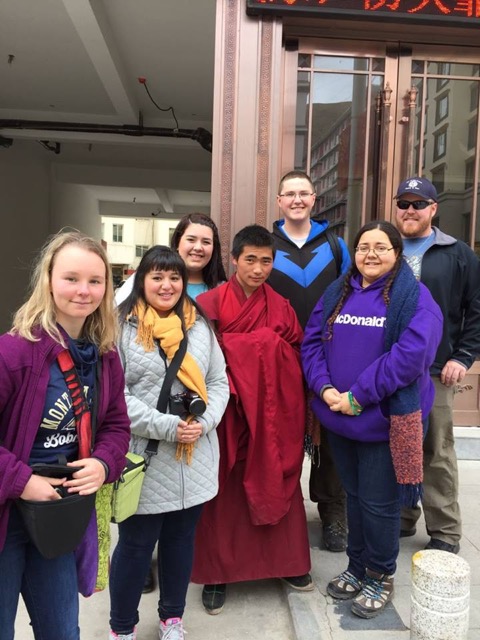https://newscenter.nmsu.edu/Articles/view/12727/a-journey-of-10-000-miles-nmsu-professors-to-share-tales-of-travels-in-china
Two New Mexico State University professors will give a talk about their joint Faculty-Led International Programs (FLIP) trip to the Gansu Province of China in March 2017.

New Mexico State University students recently went on a Faculty-Led International Programs (FLIP) trip to the Gansu Province of China. Here they took a picture with a young Tibetan monk. (Courtesy photo by Margaret Goehring)
Elvira Masson, college professor in the History Department, and Margaret Goehring, associate professor in the Department of Art, took 10 NMSU students and 10 NMSU faculty and Las Cruces community members on the trip.
The lecture kicks off the College of Arts and Sciences’ fall 2017 “Global Connections” series from 5-6:30 p.m. Wednesday, Oct. 11 at the College of Health and Social Services Annex Auditorium, Room 101A.
The purpose of the “Global Connections” lecture series is to provide an opportunity for members of the campus and surrounding community to listen and ask questions of NMSU professors about the kind of global first-hand experience they might otherwise never encounter.
“We were exploring the confluence of culture and religion that is very characteristic of the farthest west provinces of China,” Goehring said.
Specifically, the trip focused on the Silk Roads, a massive intercontinental travel network dating back to at least the first century B.C. In addition to commerce, this network provided such disparate populations at the Tibetans, the Mongolians, and the Han Chinese to experience each other’s cultures.
“We started in Xi’an, which is the eastern terminus of the Silk Roads, with the Terracotta Army,” Masson said.
The army is housed in the Mausoleum of the First Qin Emperor, a UNESCO World Heritage Site
From there the group ventured westward, on planes, boats, buses and camels, traveling a total of about 10,000 miles in 10 days.
“What struck us so much when we got out into the region was how alive Islam is,” Masson said.
Around 751 CE. militant Muslim forces forged eastward across China and battled the Tang Chinese. Though the Tang lost a major battle in this year, the eastward expansion of Islam was largely stopped but in the areas it had already conquered along the Silk Roads, there remains today a heavy concentration of Muslims and mosques.
Another aspect specifically of the Gansu Province they had not expected was how similar Gansu’s climate is to New Mexico’s.
“The sky looked just like New Mexico’s,” Masson said. “Just as crystalline as it could be. And the ground is mostly like New Mexico, just high desert.”
Among the group’s most vivid experiences were riding on camelback in Dunhuang, and visiting an ancient Tibetan Buddhist temple in Xiahe, which Masson described as freezing cold.
“The monks are bare foot, they leave their right arm exposed,” Masson said.
“All carrying cell phones,” Goehring chimed in.
“They’re chanting their sutras, elderly women are refilling the yak-butter lamps to keep them lit to pray to Buddha,” Masson said.
The students who went on the trip earned academic credit.
“It’s an academic experience,” Masson said. “We were teaching all the way through, at every site.”
The duo are planning another trip, probably to the Hubei Province, and stay in the city of Wuhan and take daytrips from there, Goehring said.
All “Global Connections” events are free and open to the public. Upcoming talks will include trips to Nepal, England and Chile.